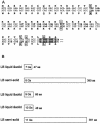Transcriptional phase variation at the flhB gene of Pseudomonas putida DOT-T1E is involved in response to environmental changes and suggests the participation of the flagellar export system in solvent tolerance
- PMID: 14996824
- PMCID: PMC355956
- DOI: 10.1128/JB.186.6.1905-1909.2004
Transcriptional phase variation at the flhB gene of Pseudomonas putida DOT-T1E is involved in response to environmental changes and suggests the participation of the flagellar export system in solvent tolerance
Abstract
Frameshift mutations in a poly(G) track at the flhB gene of Pseudomonas putida DOT-T1E are responsible for the diminished swimming of this strain on semisolid medium, which contrasts with the high swimming ability of P. putida KT2440, which does not exhibit a poly(G) track at the flhB gene. We previously showed that a mutant lacking FlhB was more sensitive to solvents than the wild-type strain (Segura et al., J. Bacteriol., 183:4127-4133, 2001). In this study, we show that swimming ability correlates with solvent tolerance in P. putida DOT-T1E, so that growth conditions favoring a functional flhB gene (growth on semisolid medium) resulted in increased innate tolerance to a sudden toluene shock.
Figures



Similar articles
-
Mutations in genes involved in the flagellar export apparatus of the solvent-tolerant Pseudomonas putida DOT-T1E strain impair motility and lead to hypersensitivity to toluene shocks.J Bacteriol. 2001 Jul;183(14):4127-33. doi: 10.1128/JB.183.14.4127-4133.2001. J Bacteriol. 2001. PMID: 11418551 Free PMC article.
-
Efflux pumps involved in toluene tolerance in Pseudomonas putida DOT-T1E.J Bacteriol. 1998 Jul;180(13):3323-9. doi: 10.1128/JB.180.13.3323-3329.1998. J Bacteriol. 1998. PMID: 9642183 Free PMC article.
-
A set of genes encoding a second toluene efflux system in Pseudomonas putida DOT-T1E is linked to the tod genes for toluene metabolism.J Bacteriol. 2000 Feb;182(4):937-43. doi: 10.1128/JB.182.4.937-943.2000. J Bacteriol. 2000. PMID: 10648517 Free PMC article.
-
Analysis of solvent tolerance in Pseudomonas putida DOT-T1E based on its genome sequence and a collection of mutants.FEBS Lett. 2012 Aug 31;586(18):2932-8. doi: 10.1016/j.febslet.2012.07.031. Epub 2012 Jul 20. FEBS Lett. 2012. PMID: 22819823 Review.
-
Mechanisms of solvent tolerance in gram-negative bacteria.Annu Rev Microbiol. 2002;56:743-68. doi: 10.1146/annurev.micro.56.012302.161038. Epub 2002 Jan 30. Annu Rev Microbiol. 2002. PMID: 12142492 Review.
Cited by
-
Proteomic analysis of Pseudomonas putida reveals an organic solvent tolerance-related gene mmsB.PLoS One. 2013;8(2):e55858. doi: 10.1371/journal.pone.0055858. Epub 2013 Feb 11. PLoS One. 2013. PMID: 23409067 Free PMC article.
-
Gene arrays at Pneumocystis carinii telomeres.Genetics. 2005 Aug;170(4):1589-600. doi: 10.1534/genetics.105.040733. Epub 2005 Jun 18. Genetics. 2005. PMID: 15965256 Free PMC article.
-
Comparative genomics of an endophytic Pseudomonas putida isolated from mango orchard.Genet Mol Biol. 2016 Jul-Sep;39(3):465-73. doi: 10.1590/1678-4685-GMB-2015-0186. Epub 2016 Jul 7. Genet Mol Biol. 2016. PMID: 27560648 Free PMC article.
-
Transcriptome dynamics of Pseudomonas putida KT2440 under water stress.Appl Environ Microbiol. 2012 Feb;78(3):676-83. doi: 10.1128/AEM.06150-11. Epub 2011 Dec 2. Appl Environ Microbiol. 2012. PMID: 22138988 Free PMC article.
-
Molecular nature of spontaneous modifications in gacS which cause colony phase variation in Pseudomonas sp. strain PCL1171.J Bacteriol. 2005 Jan;187(2):593-600. doi: 10.1128/JB.187.2.593-600.2005. J Bacteriol. 2005. PMID: 15629930 Free PMC article.
References
-
- Aizawa, S. 1996. Flagellar assembly in Salmonella typhimurium. Mol. Microbiol. 19:1-5. - PubMed
-
- Ausubel, F. M., R. Brent, R. F. Kingstom, D. D. Moore, J. G. Seidman, J. A. Smith, and K. Struhl. 1991. Current protocols in molecular biology. Greene Publishing Associates, New York, N.Y.
-
- Carroll, P. A., K. T. Tashima, M. B. Rogers, V. J. DiRita, and S. B. Calderwood. 1997. Phase variation in tcpH modulates expression of the ToxR regulon in Vibrio cholerae. Mol. Microbiol. 25:1099-1111. - PubMed
Publication types
MeSH terms
Substances
LinkOut - more resources
Full Text Sources

